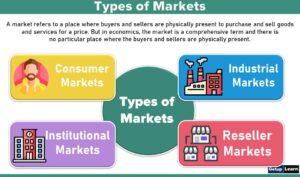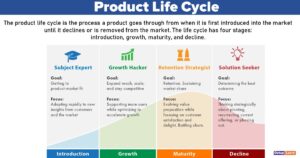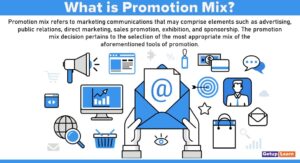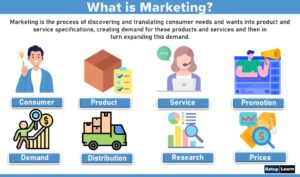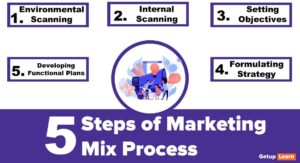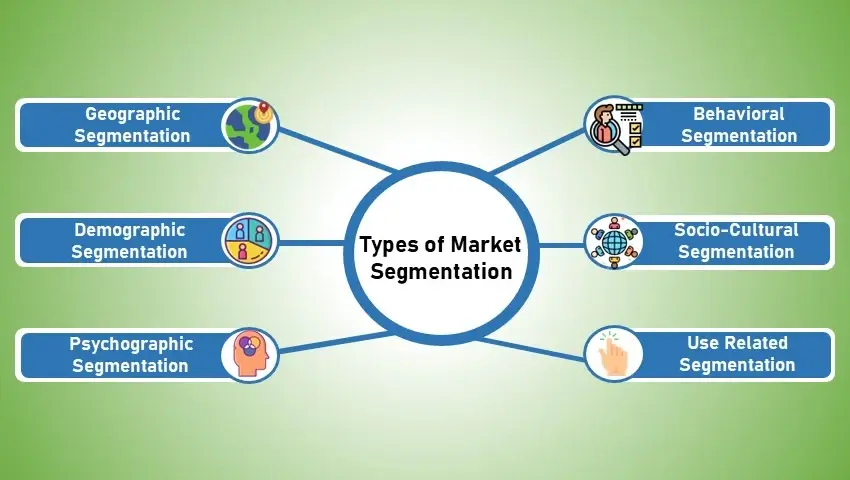
Table of Contents
Types of Market Segmentation
Let’s understand the types of market segmentation in detail:
- Geographic Segmentation
- Demographic Segmentation
- Psychographic Segmentation
- Behavioral Segmentation
- Socio-Cultural Segmentation
- Use Related Segmentation
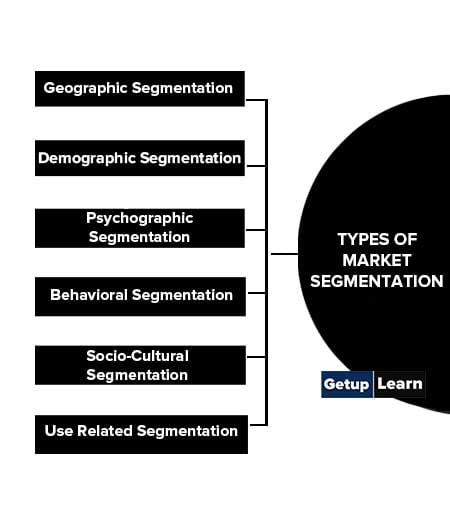
Geographic Segmentation
In geographic segmentation, the market is divided by location. The theory behind this strategy is that people who live in the same area share some similar needs and wants and that these needs and wants differ from those of people living in other areas.
For example, certain food products sell better in one region than in others. Some marketing theorists and marketing practitioners believe that worldwide satellite television transmission and global communication networks have erased all regional boundaries and therefore, that geographic segmentation should be replaced by a single global marketing strategy.
Other marketers have, for a number of years, been moving in the opposite direction and developing highly regionalized marketing strategies. In summer, geographic segmentation is a useful strategy for many marketers.
It is relatively easy to find geographically based differences for many products. In addition, geographic segments can easily be reached through the local media, including newspapers, TV, and radio, and advertisement through regional editions of magazines.
Demographic Segmentation
Demographic characteristics, such as age, sex, marital status, income, occupation, and education are most often used as the basis for market segmentation. Demography refers to the vital and measurable statistics of a population Demographics help to locate a target market, whereas psychological and socio-cultural characteristics help to describe how its members think and how they feel.
Demographic information is the most accessible and cost-effective way to identify a target market. Indeed, most secondary data, including census data, are expressed in demographic terms. Demographics are easier to measure than other segmentation variables.
They are invariably included in psychographic and socio-cultural studies because they add meaning to the findings. Demographic variables reveal ongoing trends, such as shifts in age, sex (gender), and income distributions, that signal business opportunities.
Following are the five demographic segments:
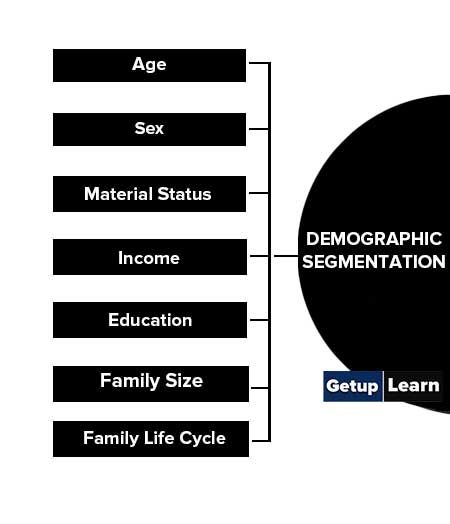
Age
Consumer requirements changes with reference to different age group. For instance, children within the age group of 0-5 years have different requirements when compared to the age group between 6-12 years. similarly, age between 6-12 years exhibits dissimilarity when compared with teens between 13-19 years.
Sex
On the basis of sex or gender market may be divided into male and female segments. Different products are offered for different segments based on their need, requirements, and suitability.
Material Status
This variable includes division on the basis of single, married, divorced, and widow segments. Each stage of consumers has its own personal and unique requirements.
Income
The market division may take different levels of income of the buyer group. For instance, the division may call for high-income, moderate-income, and low-income profile segments of the buyer group.
Education
It calls for classifying the market on the basis of the education level of the consumers. It includes divisions like high school, graduate, diploma, postgraduate, doctorate, and post-doctorate level.
Family Size
The consumer market can also be divided on the basis of the size of the family. Families with 1-2, 2-3, 3-4, and 5+ members, all exhibit inter-group differences in characteristics but intra-group similarities.
Family Life Cycle
It includes phases of individual development in life. Life cycle segmentation includes young and single.
Psychographic Segmentation
In psychographic segmentation, buyers are divided into different groups on the basis of lifestyle or personality and values. People within the same demographic group can exhibit very different psychographic profiles:
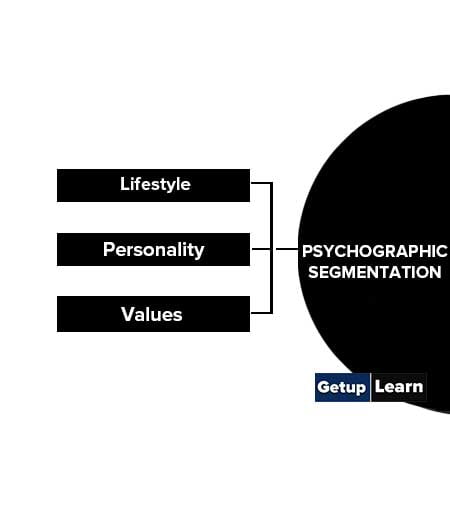
Lifestyle
People exhibit many more lifestyles than are suggested by the seven social classes, and the goods they consume express their lifestyles. Meat seems an unlikely product for lifestyle segmentation, but one Kroger supermarket in Nashville found that segmentation of self-service meat products by lifestyle, not by the type of meat, had a big payoff.
This store grounded meats by lifestyle, creating such sections as “Meals in Minutes” and “kids Love This Stuff” (hot dogs, hamburger patties, and the like). By focusing on lifestyle needs, not protein categories, Kroger encourages habitual beef and pork buyers to consider lamb and veal as well as boosting sales and profiles.
But lifestyle segmentation does not always work: Nestle introduced a special brand of decaffeinated coffee for “late-nighters,” and it failed, presumably because people saw no need for such a specialized product.
Personality
The marketer can endow their products with brand personalities that correspond to consumer personalities. Apple computer’s iMac computer, for example, has a friendly, stylish personality that appeals to buyers who do not want boring, ordinary personal computers.
Values
Core values are the belief systems that underlie consumer attitudes and behaviors. Core values go much deeper than behavior or attitude, and determine, at a basic level, people’s choices and desires over the long term. Marketers who use this segmentation variable believe that by appealing to behavior.
Although values often differ from culture to culture, roper reports have identified six values segments stretching across 35 countries: strivers (who focus more on material and professional goals), devouts (who consider tradition and duty very important), altruists (who are interested in social issues), intimates (who value close personal relationships and family highly), fun seekers (who tend to be younger and usually male), and creative’s (who are interested in education, knowledge, and technology).
Behavioral Segmentation
In behavioral segmentation, buyers are divided into groups on the basis of their knowledge of, attitude toward, use of, or response to a product. Many marketers believe that behavioral variables occasions, benefits, user status, usage rate, loyalty status, buyer-readiness stage, and attitude are the best starting points for constructing market segments.

Occasion
Segmentation can also be made on the basis of occasion. Buyers can be distinguished according to the occasions on which they develop a need, purchase a product, or use a product. Occasion segmentation can help firms expand product usage. It is believed that buyers have different needs on the basis of different occasions.
For example, buyers purchase clothes on festive occasions. Occasions in India include Diwali, Dussehra, Holi, id, X-mass, New Year, marriage anniversary, birthday, friendship day, etc.
Benefits
Buyers can be classified according to the benefits they seek. It calls upon segmenting the buyers on the basis of the product benefit. Each product category has a different benefit, and consumer purchase is based on those benefits.
Purchase decisions are made on the basis of customer’s needs and needs can be satisfied on the basis of the benefits a product is used to deliver. For example, Saffola oil seeks to give a healthy heart.
User Status
Markets can be segmented into nonusers, ex-users, potential users, first-time users, and regular users of a product. The company’s market position also influences its focus. Market leaders focus on attracting potential users, whereas smaller firms try to attract users away from the leader.
Usage Rate
Markets can be segmented into light, medium, and heavy product users. Heavy users are often a small percentage of the market but account for a high percentage of total consumption. Marketers usually prefer to attract one heavy user rather than several light users, and they very their promotional efforts accordingly.
Loyalty Status
Buyers can be divided into four groups according to brand loyalty status:
- Hard-core loyal (who always buy one brand): These types of buyers purchase one brand all the time. The buying pattern here is represented as ‘A’ since only one brand is brought all the time.
- Split loyal (who are loyal to two or three brands): Here the buyer’s choice is limited to two brands. The choice is made only by splitting it into two brands, The buying pattern is represented by AABBABAAA.
- Shifting loyal (Who shift from one brand to another): Here buyers shifts their preference from one brand to the other, the buying preference is represented by AAA BBB CCC DDD.
- Switchers (Who show no loyalty to any brand): This group of buyers does not stick to a particular brand preference, but rather they switch their preference from one brand to the other. The brand preference is represented by A B C D E F.
Each market consists of different numbers of these four types of buyers; a brand-loyal market has a high percentage of hard-core loyal. Companies that sell in such a market have a hard time gaining more market share, and new competitors have a hard time breaking in.
One caution: What appears to be brand loyalty may actually reflect habit, indifference, a low price, a high switching cost, or the non-availability of another brand. For this reason, marketers must carefully interpret what is behind observed purchasing patterns.
Buyer Readiness Stage
A market consists of people in different stages of readiness to buy a product: Some are unaware of the product, some are aware, some are informed, some are interested, some desire the product, and some intend to buy. The relative numbers make a big difference in designing the marketing program.
Attitude
Five attitude groups can be found in a market:
- Enthusiastic
- Positive
- Indifferent
- Negative
- Hostile
So, for example, workers in a political campaign use the voter’s attitude to determine how much time to spend with that voter. They may thank enthusiastic voters and remind them to vote, reinforce those who are positively disposed, and try to win the votes of indifferent voters and spend no time trying to change the attitudes of negative and hostile voters.
Socio-Cultural Segmentation
Sociology and anthropological variables- that is, socio-cultural variables- provide further bases for market segmentation.
For example, consumer markets have been successfully subdivided into segments on the basis of stages in the family life cycle, social class, core cultural values, sub-cultural memberships, and cross-cultural affiliation.

Family Life Cycle
Family life cycle segmentation is based on the premise that many families pass through similar phases in their formation, growth, and final dissolution. At each phase, the family unit needs different products and services.
The family life cycle is a composite variable based explicitly on marital and family status, but simplicity includes relative age, income, and employment status. Each of the stages in the traditional family life cycle (Le. bachelorhood, honeymooners, parenthood, past parenthood, and dissolution) represents an important target segment to a variety of marketers.
Social Class
Social class (or relative status in the community) is a potential segmentation variable. It is traditionally “measured” by a weighted index of several demographic variables, such as education, occupation, and income.
The concept of social class implies a hierarchy in which individuals in the same class generally have the same degree of status, while members of other classes have either higher or lower status. Marketers regularly have used their knowledge of social class differences to appeal to specific segments. Many major banks, for example, offer a variety of different levels of service to people of different social classes. (e.g. private banking services to the upper classes).
Culture, Subculture and Cross Culture
Some marketers have found it useful to segment their domestic and international markets on the basis of cultural heritage because members of the same culture tend to share the same values, beliefs, and customs.
Marketers who use cultural segmentation stress specific, widely held cultural values with which they hope consumers will identify. Cultural segmentation is particularly successful in international marketing, but in such instances, it is important for the marketer to understand fully the beliefs, values, and customs of the countries in which the product is marketed.
An extremely popular and effective form of segmentation categorizes consumers in terms of product, service, or brand usage characteristics, such as usage rate, awareness status, and degree of brand loyalty. Rate of usage segmentation differentiates among heavy users, medium users, light users, and nonusers of a specific product, service or brand”.
Marketers of a host of other products have also found that a relatively small group of heavy users account for a disproportionately large percentage of product usage and that targeting these heavy users has become the basis of their marketing strategy.
Other marketers take note of the gaps in market coverage for light and medium users and profitably target these segments. Awareness status encompasses the notion of consumer awareness, interval, level, on buyer readiness.
Marketers have to determine whether potential consumers are aware of the product, are interested in the product, or need to be informed about the product. Sometimes, branch loyalty is used as the basis for segmentation. Marketers often try to identify the characteristics of their brand loyal consumers so that they can direct their promotional efforts to people with similar characteristics in the larger population.
Market Segmentation Strategies
These are the market segmentation strategies explained below:

Market Aggregation
The undifferentiated strategy does not classify consumers into different groups, as specified in the segmentation process. It considers the entire buyers/consumers into one group. The firm is specialized in one product, and purchase appeal is made to all segments of the buyers.
This strategy requires large-scale production with a large distribution network and a unique marketing mix. For Example, the soft drink Pepsi is launched for all market segments irrespective of any differential variable.
Benefits of Market Aggregation
Following are the benefits of market aggregation:
- The firm concentrates only on one product.
- Large-scale production results in economies of scale which provides a competitive advantage to the firms.
- The firm can have a unique marketing strategy for all segments.
- Since there is only one product, the firm can minimize promotional costs.
- Optimum utilization of resources is possible.
Disadvantages of Market Aggregation
Following are the disadvantages of market aggregation:
- Consumers lack choices and a variety of preferences.
- Its effectiveness is doubtful in the long run business.
- It is a product-oriented, rather than a consumer-oriented strategy.
Market Segmentation
Here firms have different products which are launched into different market segments. The market is first divided into different segments on the basis of segmentation variables, and then different products are launched in different segments of the market.
Different products are meant to satisfy customers’ needs and demands as per requirements. Different marketing mix strategies are required for different segments, thus increasing the production and promotional cost of the product.
For example, Emani has two brands of products: Fair and lovely, Fair and handsome. The former is for the female segment while the latter is meant for the male segment.
Advantages of Market Segmentation
Following are the advantages of market segmentation:
- Firms have a bundle of products, which suits the requirements of different buyer groups.
- Consumers can get variety and choices as per their preferences.
- It attracts all customer groups, resulting in high sales.
Disadvantages of Market Segmentation
Following are the disadvantages of market segmentation:
- The overall cost of production is on a higher note since the low volume of production is made for individual product segments.
- Firms need to produce different products for different market segments.
- Firms need to design different marketing mixes (including advertising, sales promotion, distribution, etc.) for different products.
- The process may require high costs for research and development.
- The cost of holding finished goods inventory goes up.
Concentrated Marketing Strategy
It is also known as niche marketing. Here the firm’s product focuses on a narrowly defined segment of a market. This marketing strategy is followed by small firms that are limited by their resources. The firm chooses to operate only in the profitable segment of the market, leaving the rest of the market segment.
Advantages of Concentrated Marketing Strategy
Following are the advantages of concentrated marketing strategy:
- The firm focuses on only one segment of the market.
- Provides effective control of firms marketing policies.
- Resources can be utilized to the optimum levels.
- Can offset competitors, in that segment of the market.
Disadvantages of Concentrated Marketing Strategy
Following are the disadvantages of concentrated marketing strategy:
- Careful attempts should be made in selecting the right segment; wrong segment selection can result in product failure.
- This strategy is successful only in the short run.
- Products can be unsuccessful in a market where awareness of the available substitutes is high among the customer groups.
Effective Segmentation
Even after applying segmentation variables to a consumer or business market, marketers must realize that not all segmentations are useful. To be useful, market segments must be:
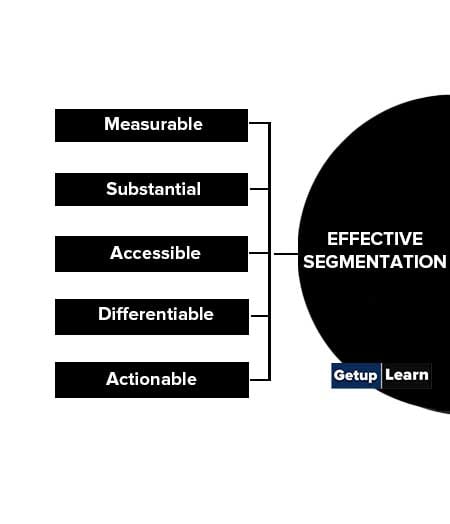
Measurable
The size, purchasing power, and characteristics of the segments can be measured.
Substantial
The segments are large and profitable enough to serve. A segment should be the largest possible homogeneous group worth going after with a tailored marketing program.
Accessible
The segments can be effectively reached and served.
Differentiable
The segments are conceptually distinguishable and respond differently to different marketing mixes. If two segments respond identically to a particular offer, they do not constitute separate segments.
Actionable
Effective programs can be formulated for attracting and serving the segments.
What are the types of market segmentation?
Types of market segmentation are given below:
1. Geographic Segmentation
2. Demographic Segmentation
3. Psychographic Segmentation
4. Behavioral Segmentation
5. Socio-Cultural Segmentation
6. Use Related Segmentation.
What are the market segmentation strategies?
Following are the market segmentation strategies:
1. Market Aggregation
2. Market Segmentation
3. Concentrated Marketing Strategy.
What is the way of effective segmentation?
These are the ways of effective segmentation:
1. Measurable
2. Substantial
3. Accessible
4. Differentiable
5. Actionable.

